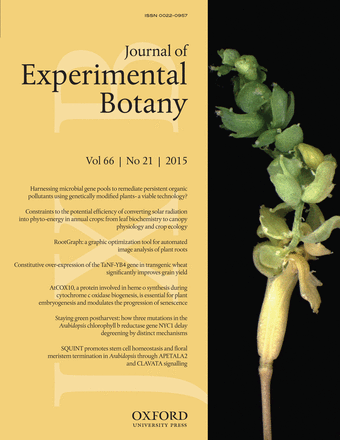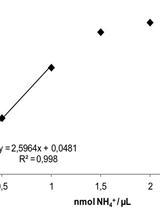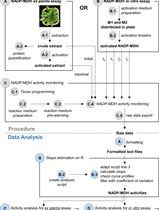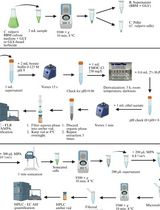- EN - English
- CN - 中文
Putrescine Biosynthesis Inhibition in Tomato by DFMA and DFMO Treatment
通过DFMA 和 DFMO 抑制番茄中腐胺的生物合成
发布: 2016年11月05日第6卷第21期 DOI: 10.21769/BioProtoc.1987 浏览次数: 8667
评审: Arsalan DaudiWenrong HeAnonymous reviewer(s)
Abstract
This protocol can be used to inhibit the biosynthesis of polyamines, specifically putrescine, in tomato plants grown with NH4+ as a solely N source. In general, polyamines are positively charged small metabolites implicated in physiological processes, including organogenesis, embryogenesis, floral initiation and development, leaf senescence, pollen tube growth, fruit development and ripening and participate in the response to abiotic and biotic stresses (Tiburcio et al., 2014). Polyamines are synthesized from amino acids by decarboxylation of ornithine or arginine by ornithine decarboxylase (ODC) or arginine decarboxylase (ADC), respectively (Walters, 2003). Tomato plants grown with NH4+ as the sole N source presented an increase of putrescine content in leaves (Fernández-Crespo et al., 2015). To assess the importance of putrescine accumulation, DL-α-(Difluoromethyl)arginine (DFMA) and DL-α-(Difluoromethyl)ornithine (DFMO), inhibitors of putrescine synthesis, were used as irreversible inhibitors of ADC and ODC enzymes, respectively (Fallon and Phillips, 1988), with the purpose of reducing cellular putrescine accumulation induced by NH4+ nutrition.
The inhibitor solution containing 2 mM DFMA and 5 mM DFMO was applied directly to each pot during the week prior to sample collection. Putrescine content was reduced by 35.3% in tomato plants grown with NH4+.
Background
The application of the inhibitors DFMA and DFMO was normally performed in MS medium and in vitro assays (Perez-Amador et al., 2002; Stes et al., 2011). However, we needed to test effectiveness of these inhibitors in vivo with the purpose to maintain natural growth conditions. Moschou et al. (2008) demonstrated the inhibition effect of DFMA and DFMO when applied in hydroponic cultures at 0.1 mM and 1 mM respectively. In this work, we used similar approaches with some modifications: the hydroponic culture was changed by vermiculite growing medium and the concentration applied for the inhibitors was modified.
Materials and Reagents
- Tomato seeds (Solanum lycopersicum Mill. cv. Ailsa Craig)
- Vermiculite (Asfaltex SA, TERMITA®)
- Potassium hydroxide (KOH) (Scharlab, catalog number: PO0275 )
- Potassium sulfate (K2SO4) (Scharlab, catalog number: PO0365 )
- Ortho-Phosphoric acid (H3PO4) (Scharlab, catalog number: AC1100 )
- Ammonium sulfate [(NH4)2SO4] (Avantor Performance Materials, J.T.Baker, catalog number: 4628 )
- Calcium sulfate dihydrate (CaSO4·2H2O) (Scharlab, catalog number: CA0285 )
- Magnesium sulfate heptahydrate (MgSO4·7H2O) (Scharlab, catalog number: MA0085 )
- Boric acid (H3BO3) (AppliChem, catalog number: 131015 )
- Manganese(II) sulfate monohydrate (MnSO4) (Scharlab, catalog number: MA0131 )
- Zinc sulfate heptahydrate (ZnSO4·7H2O) (Scharlab, catalog number: CI0207 )
- Copper(II) sulfate pentahydrate (CuSO4·5H2O) (Scharlab, catalog number: CO0101 )
- Molybdenum trioxide (MoO3) (Panreac, Vidrafoc, catalog number: 142791 )
- Sequestrene (Fe 6%) (Syngenta)
- 2-(N-Morpholino) ethanesulfonic acid sodium salt (MES sodium salt) (Sigma-Aldrich, catalog number: M3885 )
- DL-α-(Difluoromethyl)arginine (DFMA) (Santa Cruz Biotechnology, catalog number: sc-211368 )
- DL-α-(Difluoromethyl)ornithine hydrochloride (DFMO) (Santa Cruz Biotechnology, catalog number: sc-252762 )
- Distilled water
- Nutrient solution (see Recipes)
- Inhibitors mix (see Recipes)
Equipment
- Plant growth room (A.S.L Snijders)
- Pots (50 ml) (Pöppelmann, model: Serie TO )
- pH meter (HACH LANGE SPAIN, CRISON, model: GLP21 )
Software
- Statgraphics-plus software of Windows V.5 (Statistical Graphics Corp., Rockville, MD, USA)
Procedure
文章信息
版权信息
© 2016 The Authors; exclusive licensee Bio-protocol LLC.
如何引用
Fernández-Crespo, E., González-Hernández, A. I., Scalschi, L., Llorens, E., García-Agustín, P. and Camañes, G. (2016). Putrescine Biosynthesis Inhibition in Tomato by DFMA and DFMO Treatment. Bio-protocol 6(21): e1987. DOI: 10.21769/BioProtoc.1987.
分类
植物科学 > 植物生物化学 > 其它化合物
生物化学 > 蛋白质 > 活性
生物化学 > 其它化合物 > 离子
您对这篇实验方法有问题吗?
在此处发布您的问题,我们将邀请本文作者来回答。同时,我们会将您的问题发布到Bio-protocol Exchange,以便寻求社区成员的帮助。
提问指南
+ 问题描述
写下详细的问题描述,包括所有有助于他人回答您问题的信息(例如实验过程、条件和相关图像等)。
Share
Bluesky
X
Copy link














